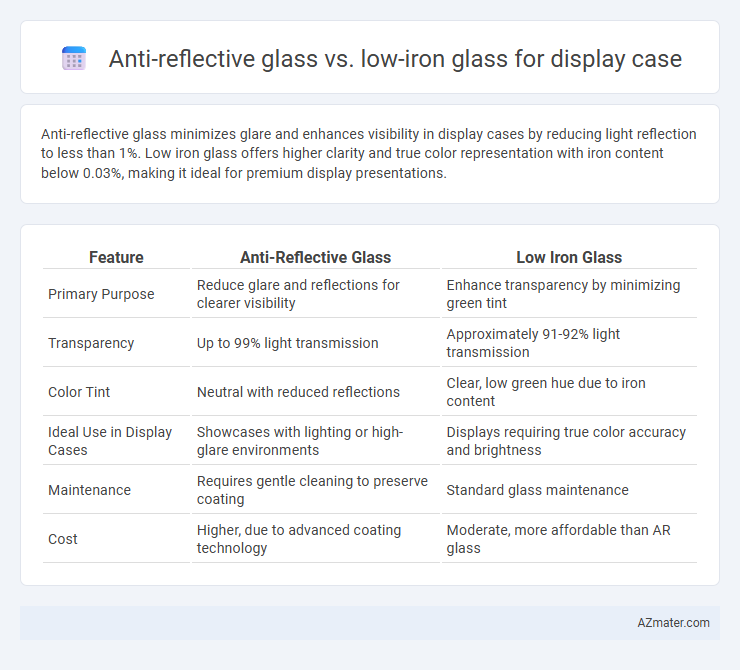Anti-reflective glass minimizes glare and enhances visibility in display cases by reducing light reflection to less than 1%. Low iron glass offers higher clarity and true color representation with iron content below 0.03%, making it ideal for premium display presentations.
Table of Comparison
| Feature | Anti-Reflective Glass | Low Iron Glass |
|---|---|---|
| Primary Purpose | Reduce glare and reflections for clearer visibility | Enhance transparency by minimizing green tint |
| Transparency | Up to 99% light transmission | Approximately 91-92% light transmission |
| Color Tint | Neutral with reduced reflections | Clear, low green hue due to iron content |
| Ideal Use in Display Cases | Showcases with lighting or high-glare environments | Displays requiring true color accuracy and brightness |
| Maintenance | Requires gentle cleaning to preserve coating | Standard glass maintenance |
| Cost | Higher, due to advanced coating technology | Moderate, more affordable than AR glass |
Introduction to Display Case Glass Options
Display case glass options prominently include Anti-reflective glass and Low iron glass, each enhancing visibility and aesthetics in different ways. Anti-reflective glass minimizes glare and reflections, improving the clarity of showcased items under various lighting conditions. Low iron glass offers superior transparency and color fidelity by reducing the green tint common in standard glass, making it ideal for premium display cases requiring true color representation.
What is Anti-Reflective Glass?
Anti-reflective glass is specially coated to minimize surface reflections, enhancing visibility and clarity in display cases by reducing glare caused by ambient light. This glass improves the viewing experience by allowing more light to pass through, typically achieving reflectance levels below 1%, compared to standard glass that can reflect around 8%. Unlike low iron glass, which primarily reduces green tint and increases transparency, anti-reflective glass focuses on optical performance by eliminating reflections, making it ideal for high-end display cases showcasing valuable items.
What is Low Iron Glass?
Low iron glass is a type of glass with reduced iron content, resulting in higher clarity and less green tint compared to standard glass. It enhances color accuracy and transparency, making it ideal for display cases where true color representation is crucial. While anti-reflective glass minimizes glare and reflections, low iron glass primarily improves visual clarity and brightness in displays.
Key Differences Between Anti-Reflective and Low Iron Glass
Anti-reflective glass for display cases reduces surface glare by applying a micro-layer coating that minimizes light reflection, enhancing visibility and color fidelity of exhibited items. Low iron glass contains reduced iron content, resulting in higher clarity and less green tint compared to standard glass, providing a clearer view but without significant anti-glare properties. The key differences lie in anti-reflective glass's focus on glare reduction for improved visibility under bright lighting, whereas low iron glass emphasizes pure transparency and color accuracy without the specialized coating.
Visual Clarity and Transparency Comparison
Anti-reflective glass enhances display case visual clarity by significantly reducing surface glare and reflections, resulting in more vibrant and true-to-life presentations. Low iron glass offers superior transparency due to its reduced iron content, minimizing the greenish tint typical in standard glass and providing a clearer view of displayed items. Comparing the two, anti-reflective glass excels in glare reduction, while low iron glass maximizes light transmission and color accuracy, making the choice dependent on specific display needs.
Light Transmission and Glare Reduction
Anti-reflective glass offers superior glare reduction by minimizing surface reflections, allowing up to 99% light transmission, which enhances the clarity and visibility of display case contents. Low iron glass provides higher light transmission compared to standard glass, typically around 91-92%, by reducing the green tint, but it does not significantly reduce glare. For optimal display case performance, anti-reflective glass is preferred when glare reduction and maximum light transmission are critical for visual presentation.
Durability and Maintenance Considerations
Anti-reflective glass offers superior durability with scratch-resistant coatings that maintain clarity over time, reducing the need for frequent cleaning in display cases. Low iron glass provides enhanced transparency and color accuracy but can be more susceptible to surface damage and requires careful maintenance to prevent visible wear. For long-lasting performance and minimal upkeep, anti-reflective glass is often the preferred choice in high-traffic display environments.
Cost Analysis: Anti-Reflective vs Low Iron Glass
Anti-reflective glass typically incurs higher upfront costs due to specialized coatings that reduce glare and improve display clarity, making it ideal for premium display cases. Low iron glass offers a cost-effective alternative with enhanced transparency and reduced green tint, but lacks the advanced glare reduction properties of anti-reflective options. When budgeting for display cases, the price differential and the specific visual performance requirements should guide the choice between anti-reflective and low iron glass.
Ideal Applications for Each Glass Type
Anti-reflective glass is ideal for high-end display cases in museums and retail environments where minimizing glare and reflections enhances viewer experience and showcases fine details. Low iron glass offers superior clarity and color accuracy, making it perfect for luxury displays and aquariums where transparency and true color representation are essential. Both glass types improve visibility but serve different purposes based on the need for reflection control or maximum optical clarity.
Choosing the Best Glass for Your Display Case
Choosing the best glass for your display case depends on your priorities: anti-reflective glass minimizes glare and enhances visibility by reducing reflection, ideal for environments with strong lighting or direct sunlight. Low iron glass offers superior clarity and a natural true-color view by eliminating the green tint typical in standard glass, making it perfect for showcasing items where color accuracy is crucial. Evaluating factors such as lighting conditions, budget, and the importance of color fidelity will guide you in selecting between anti-reflective and low iron glass for an optimal display presentation.

Infographic: Anti-reflective glass vs Low iron glass for Display case
 azmater.com
azmater.com